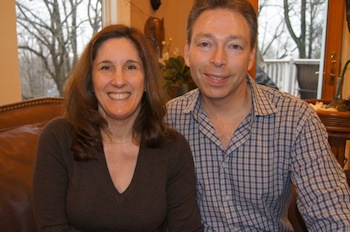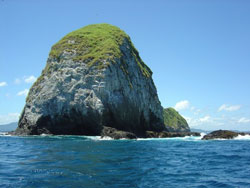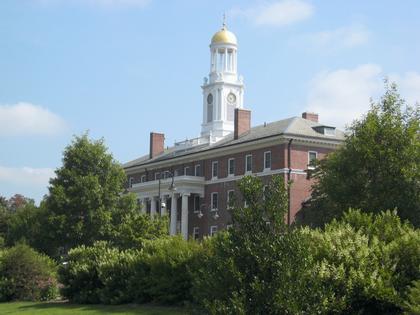Back from the Dead and Very Much Alive
- Tuesday, 11 December 2012 08:26
- Last Updated: Tuesday, 11 December 2012 08:44
- Published: Tuesday, 11 December 2012 08:26
- Hits: 9004
 When Bill and Hilary Greenberg flew to Costa Rica in April 2012 for a scuba vacation they were not new to diving. In fact, they took their first dive together on their honeymoon 18 years ago and have been going to the bottom of the ocean ever since. Both physicians and certified divers they felt secure enough to introduce their three boys, ages 15, 14 and 11 to the sport and planned another idyllic week diving in the indigo waters of the Catalina Islands off the western shore of Costa Rica under the supervision of Pacific Coast Divers. The area is known as a scuba haven with a spectacular array of marine life.
When Bill and Hilary Greenberg flew to Costa Rica in April 2012 for a scuba vacation they were not new to diving. In fact, they took their first dive together on their honeymoon 18 years ago and have been going to the bottom of the ocean ever since. Both physicians and certified divers they felt secure enough to introduce their three boys, ages 15, 14 and 11 to the sport and planned another idyllic week diving in the indigo waters of the Catalina Islands off the western shore of Costa Rica under the supervision of Pacific Coast Divers. The area is known as a scuba haven with a spectacular array of marine life.
Less than 24 hours into their trip they set out for their first dive. Hilary and Bill planned to spend the day with one instructor and sent the boys off with another instructor to work on mastering their diving skills. After the morning dive the group gathered on the boat to rest and snack and then set out near a coral reef for their afternoon dive.
The instructor told the group to follow the current next to the reef and they all plunged in. About ten minutes into the dive the  group was hit by a sudden surge and pushed rapidly through a rock formation. Just seconds after the rush, Bill looked up and realized that Hilary was nowhere to be found. He frantically signaled to the instructor who signaled the group to stay put while he swam back upstream from where they had come. Minutes later he was back and signaled that she was not there. The instructor motioned for the group to continue forward and as they swam on Bill caught a glimpse of Hilary's dive suit at the bottom of the reef. He swam to the other side of the reef and found her lying on the coral, unresponsive and without her regulator in her mouth.
group was hit by a sudden surge and pushed rapidly through a rock formation. Just seconds after the rush, Bill looked up and realized that Hilary was nowhere to be found. He frantically signaled to the instructor who signaled the group to stay put while he swam back upstream from where they had come. Minutes later he was back and signaled that she was not there. The instructor motioned for the group to continue forward and as they swam on Bill caught a glimpse of Hilary's dive suit at the bottom of the reef. He swam to the other side of the reef and found her lying on the coral, unresponsive and without her regulator in her mouth.
Bill and the dive master lifted Hilary's lifeless body up to the surface of the water and inflated her buoyancy control device. Once on top of the water Bill attempted to do CPR in the water but only managed to get a few breaths into her while they awaited the boat, which was some distance away. Due to the waves and the distance, the instructor was having trouble making contact with it. It was several minutes before it arrived. When it did, they hoisted her onto the floor of the boat and Bill continued to do CPR, checking for a pulse – which he could not detect.
At that point, his wife's eyes were dilated and fixed, her lips blue, and she had no pulse. Bill continued the CPR, desperately hoping that he would soon see some sign of life. But as the minutes wore on, she failed to resume breathing, her eyes stared into nothingness, he felt no pulse and began to fear that his efforts were in vain.
In normal medical practice CPR should be applied for 20 minutes, although it has been suggested that more extended CPR can be effective. Bill and the others continued to work on her as they waited for the boat to get them back to shore.
Diving protocol requires that the boat stay out until all the divers in the area could be retrieved. At some point, the Greenberg's three boys returned to the boat and saw their mom lying lifeless and their dad desperately attempting to revive her.
Some 20 minutes after she was hauled out of the water, the Costa Rican Coast Guard arrived in a boat and Bill was hopeful that their EMT's would take over the CPR. The Coast Guard team boarded the boat, put a mask over Hilary's face and started to give her oxygen. However Bill realized that the mask was leaking and that Hilary's chest was not rising and falling with each surge of oxygen. He waved off the EMT's and resumed his efforts while the boat travelled to shore.
They were met at the beach by an EMS team and a doctor with a defibrillator that was attached to Hilary and showed that she had a heart rhythm. That team intubated Hilary – putting a tube down her throat so that they could have better control of her airway and quickly hoisted her into an ambulance for the 40-minute ride to the nearest hospital.
Bill travelled in another ambulance behind Hilary and the boys followed in a car not knowing if their mother would come out of this alive. Once at the hospital the doctors ran a few tests on Hilary. She remained unresponsive and appeared to be in a coma. Her breathing was stabilized but there was little else that was hopeful about her status. The Diver's Alert Network (DAN) quickly swung into action and was able to arrange air transport from Costa Rica to Florida that night for the Greenberg family. They moved swiftly and around 10 pm they took off for Ft. Lauderdale Airport with Hilary stretched out in the middle of the small plane hooked up to the ventilator. Once they landed, they were met by an ambulance that transported Hilary to Del Ray Hospital.
The family ended up staying in Del Ray from Sunday until the following Saturday where Hilary remained unresponsive and breathing with the help of the ventilator. Though her legs and arms moved she could not follow any commands. A CT scan of her brain showed no injury but doctors could not assess her chances of recovering. They simply said it was "too early to tell" and "we have to be lucky." When the family left on Saturday, Hilary's eyes had begun to track but there were no other signs of brain function.
Ten days after the accident it was determined that she could breathe on her own and she was transported to the Neuro ICU at Columbia University Hospital in New York. Despite one doctor's claim that she was brain dead, the second set of tests performed at Columbia looked more positive.
On the second day of her stay at Columbia, the first of many miracles occurred. According to her medical school friend Dr. Diana Deutsch. here's an account of Hilary's first breakthrough. "When Hilary came back to New York after being stabilized enough to travel, I got to see her at the Columbia Neuro ICU for the first time. It was horrifying to see her in that state, and yet hope came when suddenly, out of a semiconscious state, she looked me right in the eye and said, 'Diana, please help me.' This is the first responsive thing she had said since the accident."
 Hilary's brother-in-law Mitch also came by and Hilary recognized him and called out his name. The staff at Columbia began occupational therapy and kept her there for four days until they could get her into Burke Rehabilitation Hospital in White Plains. Once there, though she was still "semi-comatose" they decided to lift the pain medications she was on due to the injury to her ribs during CPR and that helped to improve her mental state.
Hilary's brother-in-law Mitch also came by and Hilary recognized him and called out his name. The staff at Columbia began occupational therapy and kept her there for four days until they could get her into Burke Rehabilitation Hospital in White Plains. Once there, though she was still "semi-comatose" they decided to lift the pain medications she was on due to the injury to her ribs during CPR and that helped to improve her mental state.
She began to make small improvements though she still had great difficulty speaking and was only able to name a few fruits at the start. Though her husband visited her daily, she had no memory of his visits, and each time he came she accused him of "never coming to see her." She finally asked her friend to post a sign-in sheet on the wall so that she could track who had been in to see her. She kept insisting she was stupid until another friend assured her that she had graduated Phi Beta Kappa from Wellesley and that she was frustrated, not stupid. During her five-week stay at Burke, she required constant supervision and was secured to her bed as she was so confused that she would walk into walls. At times she thought she was at the hospital working as a doctor, and tried to wheel herself out of the facility to go home.
Speaking about that time in Hilary's recovery, lifelong friend Wendy Stober says, "Hilary would get annoyed with me when I would arrive at Burke in the morning and would not take her home. She so desperately wanted to go home. She would tell the nurse that I did not care about my children so I could stay but she needed to go home to her boys. She knew she had children and she so very much wanted to be with them and take care of them."
Hilary continually asked for her sister and her father, though her sister had passed away ten years earlier and her dad had been gone for five. Bill decided to let her know that they were gone and she cried for hours, re-experiencing her initial grief at the loss.
Following five weeks of intensive therapy Hilary was given the okay to go home. Even at the house she required 24/7 supervision, and also continued to return to Burke three days a week for speech and cognitive therapy.
Neighbors in Edgemont jumped to her aid. They did everything from supplying months of meals to the family, to supervising Hilary at home and scheduling her rides to and from therapy at Burke throughout the summer.
Now six months after the accident, doctors predict that Hilary will make a 100% recovery – but by all outward signs she's already there. She speaks fluidly, has a wonderful sense of humor and shows no outward signs of the trauma she experienced. Her rehab nurses have told her that her speedy recovery was helped by her natural intelligence. She looks forward to taking her medical boards in April and getting back to work when she is fully recovered.
How could someone recover completely after being without oxygen for an estimated nine minutes? Though doctors say this is a unique case, Bill has several theories. At the time of the drowning, Hilary was in very cold water and the hypothermia may have helped to prevent injury to her brain cells. More importantly, Bill performed CPR for a full 45 minutes – never giving up, though traditionally codes end in the hospital after patients fail to respond in 20 minutes. He notes that following her accident new research was announced in the NY Times that confirmed that prolonged CPR improves the chance of survival.
Many factors may have contributed to Hilary's surprising come back. Among these are the power of prayer, as the Jewish prayer for healing, known as the Mi Sheberakh was being said for her at temples all over the country. Her will to live and diligent approach to therapy also may have helped. But she gives full credit to her husband Bill's knowledge of CPR and his valiant efforts to save her – when from all appearances she was gone. She's very much alive today and encourages everyone who is reading this article to learn CPR – just in case!
Drs. William and Hilary Gleekman-Greenberg live in Edgemont with their three boys. Bill recently opened SkinTheraP, specializing in cosmetic medicine on the Popham Road Bridge in Scarsdale.







